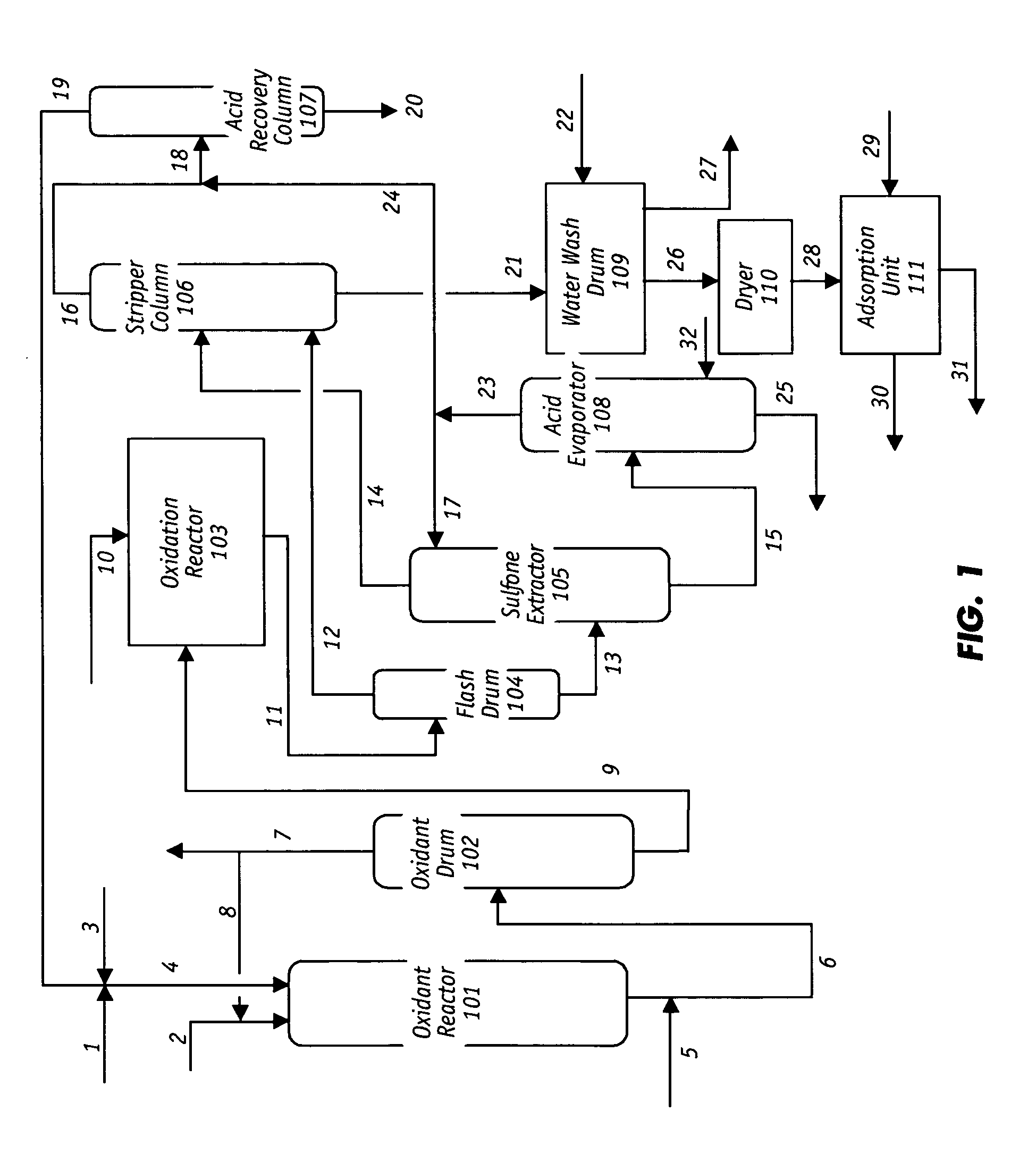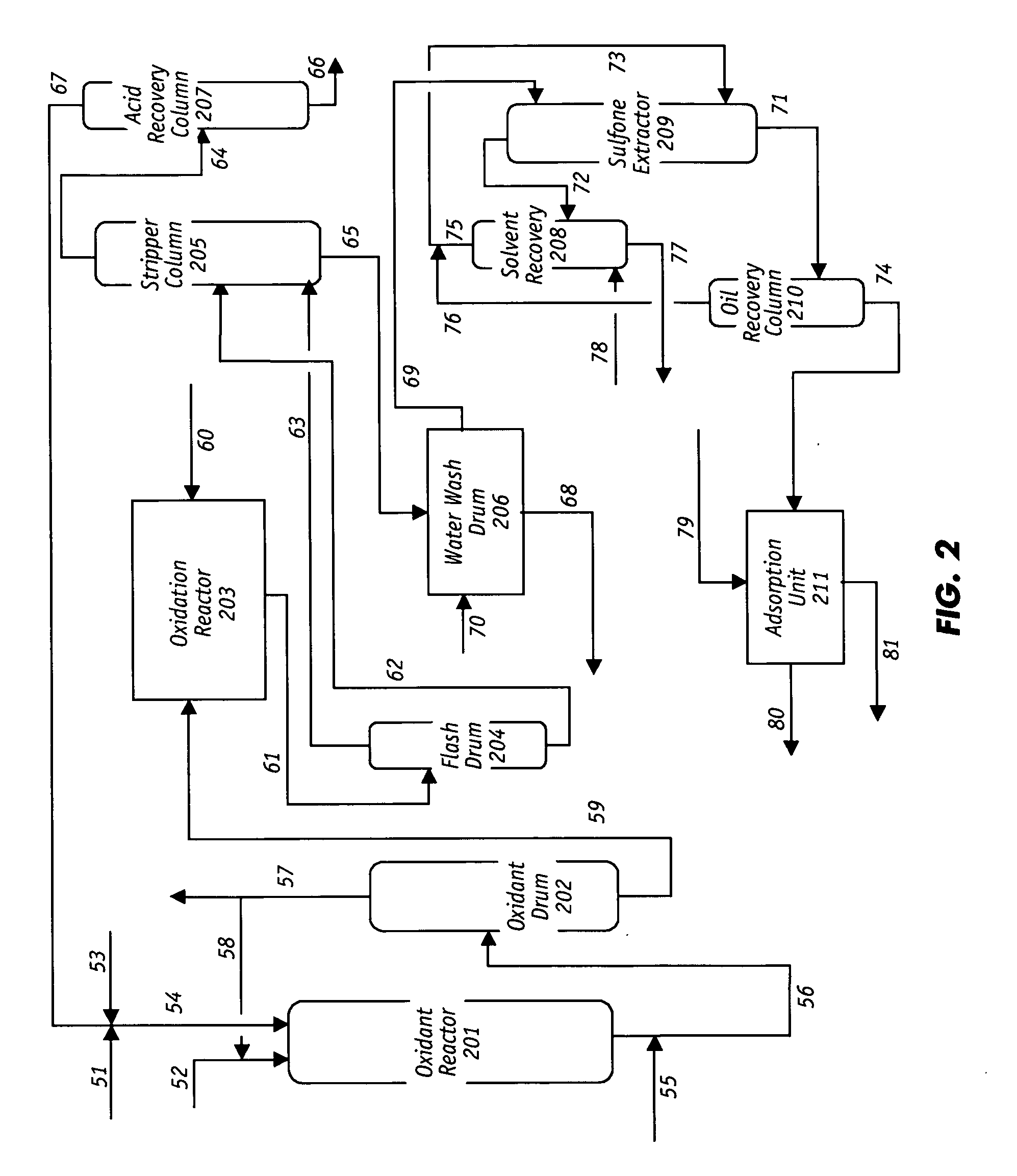Oxidative desulfurization and denitrogenation of petroleum oils
a petroleum oil and desulfurization technology, applied in the direction of organic chemistry, refining with oxygen compounds, acid-containing liquid refining, etc., can solve the problems of inability to easily treat by hds, the operation temperature and pressure of hds is more stringent, and the need for sulfur removal
- Summary
- Abstract
- Description
- Claims
- Application Information
AI Technical Summary
Benefits of technology
Problems solved by technology
Method used
Image
Examples
example 1
[0047] In this example non-aqueous oxidants suitable for the selective oxidation of sulfur and nitrogen compounds in petroleum oils were prepared. A liquid reactant containing 20 vol. % acetaldehyde (AcH), 80 vol. % acetone, and 7 ppm Fe(III) acetylacetone (FeAA) (catalyst) was fed co-currently with chemical grade oxygen gas to the top of a 0.94 cm diameter jacketed reactor column, which was packed with 20-40 mesh ceramic packing material that was 30 cm in length. Water having a constant temperature was circulated through the reactor jacket to control the reaction temperature. The flow rate of the liquid reactant into the reactor was at 1.5 ml per minute and the flow rate of oxygen gas was at 200 ml per minute. Three experimental runs were carried out at temperatures of 39, 45, and 60° C., under a constant reactor pressure of 6.1 atm. The results are summarized in Table 1.
TABLE 1Temper-AcHatureProduct Composition (wt %)Conversion(C. °)PAAAAH2OCO2AcHAcetone(wt %)3918.61.8Trace0.065...
example 2
[0049] A series of oxidation experiments were conducted on a treated light gas oil (TLGO), which had the following composition and properties: [0050] 1. Elemental Composition: carbon 86.0 wt %; hydrogen 12.9 wt %; sulfur 301 ppm; and nitrogen 5.0 ppm. [0051] 2. Asphaltene: 0 wt % [0052] 3. Density: 892 (kg / m3) @ 15° C.; 875 (kg / m3) @20° C. [0053] 4. Viscosity: 6.5 (mPa-s) @ 20° C. [0054] 5. Solid Concentration: 140 ppm
[0055] TLGO feed was mixed with a sufficient amount of non-aqueous oxidant that was prepared in Example 1 in a glass batch reactor that was equipped with a stirrer. The oxidation was conducted at 50° C. for 15 minutes. The ratios of actual added PAA to the stoichiometric required PAA were varied from 1.8 to 5.0 to determine the optimal ratio for complete oxidation of the sulfur and nitrogen compounds in the TLGO. No phase separation or solid precipitation was observed in any of the runs. The results of gas chromatography (GC) analysis with an atomic emission detector ...
example 3
[0056] 602 grams of diesel (D198S) were mixed with a sufficient amount of non-aqueous oxidant that was prepared in Example 1 in a glass batch reactor that was equipped with a stirrer. The added oxidant contained 3.0 times of the stoichiometric amount of PAA needed, i.e., 1.850 grams based on the sulfur content in the diesel, in order to enhance the oxidation reactions with the sulfur and nitrogen compounds. The oxidation was conducted at 60° C. for 15 minutes, and then the reactor content was heated to 130° C. in 15 minutes and maintained at this temperature for 20 minutes. Again, no phase separation or solid precipitation was observed. The oxidized diesel (198S-O3h) was washed with water to remove the minor amounts of AA which was generated from PAA in the oxidation reactor. The yield of diesel from the oxidation step was essentially 100% since the washed diesel (198S-O3hw) weighed approximately 601 grams, which is almost the same weight as the diesel feed. The washed diesei was th...
PUM
 Login to View More
Login to View More Abstract
Description
Claims
Application Information
 Login to View More
Login to View More - R&D
- Intellectual Property
- Life Sciences
- Materials
- Tech Scout
- Unparalleled Data Quality
- Higher Quality Content
- 60% Fewer Hallucinations
Browse by: Latest US Patents, China's latest patents, Technical Efficacy Thesaurus, Application Domain, Technology Topic, Popular Technical Reports.
© 2025 PatSnap. All rights reserved.Legal|Privacy policy|Modern Slavery Act Transparency Statement|Sitemap|About US| Contact US: help@patsnap.com



